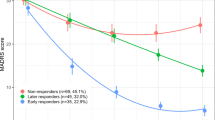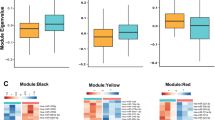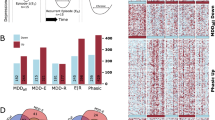Abstract
Drugs that target glutamate neuronal transmission, such as memantine, offer a novel approach to the treatment of late-life depression, which is frequently comorbid with cognitive impairment. The results of our recently published double-blind, randomized, placebo-controlled trial of escitalopram or escitalopram/memantine in late-life depression with subjective memory complaints (NCT01902004) indicated no differences between treatments in depression remission, but additional benefits in cognition at 12-month follow-up with combination treatment. To identify pathways and biological functions uniquely induced by combination treatment that may explain cognitive improvements, we generated transcriptional profiles of remission compared with non-remission from whole blood samples. Remitters to escitalopram compared with escitalopram/memantine combination treatment display unique patterns of gene expression at baseline and 6 months after treatment initiation. Functional enrichment analysis demonstrates that escitalopram-based remission associates to functions related to cellular proliferation, apoptosis, and inflammatory response. Escitalopram/memantine-based remission, however, is characterized by processes related to cellular clearance, metabolism, and cytoskeletal dynamics. Both treatments modulate inflammatory responses, albeit via different effector pathways. Additional research is needed to understand the implications of these results in explaining the observed superior effects of combination treatment on cognition observed with prolonged treatment.
This is a preview of subscription content, access via your institution
Access options
Subscribe to this journal
Receive 12 print issues and online access
$259.00 per year
only $21.58 per issue
Buy this article
- Purchase on Springer Link
- Instant access to full article PDF
Prices may be subject to local taxes which are calculated during checkout




Similar content being viewed by others
References
Conwell Y, Duberstein PR, Cox C, Herrmann J, Forbes N, Caine ED. Age differences in behaviors leading to completed suicide. Am J Geriatr Psychiatry. 1998;6:122–6.
Lavretsky H, Lesser IM, Wohl M, Miller BL. Relationship of age, age at onset, and sex to depression in older adults. Am J Geriatr Psychiatry. 1998;6:248–56.
Rush AJ, Trivedi MH, Wisniewski SR, Nierenberg AA, Stewart JW, Warden D, et al. Acute and longer-term outcomes in depressed outpatients requiring one or several treatment steps: a STAR*D report. Am J Psychiatry. 2006;163:1905–17.
Reynolds CF 3rd, Dew MA, Pollock BG, Mulsant BH, Frank E, Miller MD, et al. Maintenance treatment of major depression in old age. N Engl J Med. 2006;354:1130–8.
Bhalla RK, Butters MA, Becker JT, Houck PR, Snitz BE, Lopez OL, et al. Patterns of mild cognitive impairment after treatment of depression in the elderly. Am J Geriatr Psychiatry. 2009;17:308–16.
Steffens DC. Separating mood disturbance from mild cognitive impairment in geriatric depression. Int Rev Psychiatry. 2008;20:374–81.
Vega JN, Zurkovsky L, Albert K, Melo A, Boyd B, Dumas J, et al. Altered brain connectivity in early postmenopausal women with subjective cognitive impairment. Front Neurosci. 2016;10:433.
Bauer ME, Teixeira AL. Inflammation in psychiatric disorders: what comes first? Ann NY Acad Sci. 2019;1437:57–67.
Lavretsky H, Laird KT, Krause-Sorio B, Heimberg BF, Yeargin J, Grzenda A, et al. A randomized double-blind placebo-controlled trial of combined escitalopram and memantine for older adults with major depression and subjective memory complaints. Am J Geriatr Psychiatry. 2020;28:178–90.
Pelton GH, Harper OL, Roose SP, Marder K, D’Antonio K, Devanand DP. Combined treatment with memantine/es‐citalopram for older depressed patients with cognitive impairment: a pilot study. Int J Geriatr Psychiatry. 2016;31:648–55.
Zhu GQ, Li JY, He L, Wang XC, Hong XQ. MPTP-induced changes in hippocampal synaptic plasticity and memory are prevented by memantine through the BDNF-TrkB pathway. Br J Pharm. 2015;172:2354–68.
Maekawa M, Namba T, Suzuki E, Yuasa S, Kohsaka S, Uchino S. NMDA receptor antagonist memantine promotes cell proliferation and production of mature granule neurons in the adult hippocampus. Neurosci Res. 2009;63:259–66.
Ficek J, Zygmunt M, Piechota M, Hoinkis D, Rodriguez Parkitna J, Przewlocki R, et al. Molecular profile of dissociative drug ketamine in relation to its rapid antidepressant action. BMC Genom. 2016;17:362.
Drever BD, Anderson WG, Johnson H, O’Callaghan M, Seo S, Choi DY, et al. Memantine acts as a cholinergic stimulant in the mouse hippocampus. J Alzheimers Dis. 2007;12:319–33.
Nyakas C, Granic I, Halmy LG, Banerjee P, Luiten PG. The basal forebrain cholinergic system in aging and dementia. Rescuing cholinergic neurons from neurotoxic amyloid-beta42 with memantine. Behav Brain Res. 2011;221:594–603.
Wang YC, Sanchez-Mendoza EH, Doeppner TR, Hermann DM. Post-acute delivery of memantine promotes post-ischemic neurological recovery, peri-infarct tissue remodeling, and contralesional brain plasticity. J Cereb Blood Flow Metab. 2017;37:980–93.
Lopez-Valdes HE, Clarkson AN, Ao Y, Charles AC, Carmichael ST, Sofroniew MV, et al. Memantine enhances recovery from stroke. Stroke. 2014;45:2093–100.
Wong P, Leppert IR, Roberge D, Boudam K, Brown PD, Muanza T, et al. A pilot study using dynamic contrast enhanced-MRI as a response biomarker of the radioprotective effect of memantine in patients receiving whole brain radiotherapy. Oncotarget. 2016;7:50986–96.
Duman JG, Dinh J, Zhou W, Cham H, Mavratsas VC, Paveskovic M, et al. Memantine prevents acute radiation-induced toxicities at hippocampal excitatory synapses. Neuro Oncol. 2018;20:655–65.
Lynch M. Preservation of cognitive function following whole brain radiotherapy in patients with brain metastases: complications, treatments, and the emerging role of memantine. J Oncol Pharm Pract. 2019;25:657–62.
Yoon WS, Yeom MY, Kang ES, Chung YA, Chung DS, Jeun SS. Memantine induces NMDAR1-mediated autophagic cell death in malignant glioma cells. J Korean Neurosurg Soc. 2017;60:130–7.
Cacciatore I, Fornasari E, Marinelli L, Eusepi P, Ciulla M, Ozdemir O, et al. Memantine-derived drugs as potential antitumor agents for the treatment of glioblastoma. Eur J Pharm Sci. 2017;109:402–11.
Wang F, Zou Z, Gong Y, Yuan D, Chen X, Sun T. Regulation of human brain microvascular endothelial cell adhesion and barrier functions by memantine. J Mol Neurosci. 2017;62:123–9.
Wu HM, Tzeng NS, Qian L, Wei SJ, Hu X, Chen SH, et al. Novel neuroprotective mechanisms of memantine: increase in neurotrophic factor release from astroglia and anti-inflammation by preventing microglial activation. Neuropsychopharmacology. 2009;34:2344–57.
Huber W, Carey VJ, Gentleman R, Anders S, Carlson M, Carvalho BS, et al. Orchestrating high-throughput genomic analysis with bioconductor. Nat Methods. 2015;12:115–21.
Carvalho BS, Irizarry RA. A framework for oligonucleotide microarray preprocessing. Bioinformatics. 2010;26:2363–7.
Ritchie ME, Phipson B, Wu D, Hu Y, Law CW, Shi W, et al. limma powers differential expression analyses for RNA-sequencing and microarray studies. Nucleic Acids Res. 2015;43:e47.
Benjamini Y, Drai D, Elmer G, Kafkafi N, Golani I. Controlling the false discovery rate in behavior genetics research. Behav Brain Res. 2001;125:279–84.
Plaisier SB, Taschereau R, Wong JA, Graeber TG. Rank-rank hypergeometric overlap: identification of statistically significant overlap between gene-expression signatures. Nucleic Acids Res. 2010;38:e169.
Sergushichev A. An algorithm for fast preranked gene set enrichment analysis using cumulative statistic calculation. BioRxiv. 2016. https://doi.org/10.1101/060012.
Isserlin R, Merico D, Voisin V, Bader GD. Enrichment map—a Cytoscape app to visualize and explore OMICs pathway enrichment results. F1000 Res. 2014;3:141.
Shannon P, Markiel A, Ozier O, Baliga NS, Wang JT, Ramage D, et al. Cytoscape: a software environment for integrated models of biomolecular interaction networks. Genome Res. 2003;13:2498–504.
Castren E, Hen R. Neuronal plasticity and antidepressant actions. Trends Neurosci. 2013;36:259–67.
Taupin P. Neurogenesis and the effect of antidepressants. Drug Target Insights. 2006;1:13–17.
Liu Y, Huang Y, Xu Y, Qu P, Wang M. Memantine protects against ischemia/reperfusion-induced brain endothelial permeability. IUBMB Life. 2018;70:336–43.
Paltsev MA, Zuev VA, Kozhevnikova EO, Linkova NS, Kvetnaia TV, Polyakova VO, et al. Molecular markers of early diagnosis of Alzheimer disease: prospects for research in peripheral tissues. Adv Gerontol. 2018;8:111–8.
Anacker C, Zunszain PA, Cattaneo A, Carvalho LA, Garabedian MJ, Thuret S, et al. Antidepressants increase human hippocampal neurogenesis by activating the glucocorticoid receptor. Mol Psychiatry. 2011;16:738–50.
Malykhin NV, Carter R, Seres P, Coupland NJ. Structural changes in the hippocampus in major depressive disorder: contributions of disease and treatment. J Psychiatry Neurosci. 2010;35:337–43.
Bocchio-Chiavetto L, Maffioletti E, Bettinsoli P, Giovannini C, Bignotti S, Tardito D, et al. Blood microRNA changes in depressed patients during antidepressant treatment. Eur Neuropsychopharmacol. 2013;23:602–11.
Pettai K, Milani L, Tammiste A, Vosa U, Kolde R, Eller T, et al. Whole-genome expression analysis reveals genes associated with treatment response to escitalopram in major depression. Eur Neuropsychopharmacol. 2016;26:1475–83.
Konietzny A, Bar J, Mikhaylova M. Dendritic actin cytoskeleton: structure, functions, and regulations. Front Cell Neurosci. 2017;11:147.
Levkovitz Y, Gil-Ad I, Zeldich E, Dayag M, Weizman A. Differential induction of apoptosis by antidepressants in glioma and neuroblastoma cell lines. J Mol Neurosci. 2005;27:29–42.
Rizzoli R, Cooper C, Reginster JY, Abrahamsen B, Adachi JD, Brandi ML, et al. Antidepressant medications and osteoporosis. Bone. 2012;51:606–13.
Galecki P, Mossakowska-Wojcik J, Talarowska M. The anti-inflammatory mechanism of antidepressants—SSRIs, SNRIs. Prog Neuropsychopharmacol Biol Psychiatry. 2018;80(Pt C):291–4.
Ellul P, Mariotti-Ferrandiz E, Leboyer M, Klatzmann D. Regulatory T cells as supporters of psychoimmune resilience: toward immunotherapy of major depressive disorder. Front Neurol. 2018;9:167.
Szalach LP, Lisowska KA, Cubala WJ. The influence of antidepressants on the immune system. Arch Immunol Ther Exp. 2019;67:143–51.
Babic Leko M, Willumsen N, Nikolac Perkovic M, Klepac N, Borovecki F, Hof PR, et al. Association of MAPT haplotype-tagging polymorphisms with cerebrospinal fluid biomarkers of Alzheimer’s disease: a preliminary study in a Croatian cohort. Brain Behav. 2018;8:e01128.
Lasky JL, Wu H. Notch signaling, brain development, and human disease. Pediatr Res. 2005;57:104–9.
Yao PJ, Petralia RS, Mattson MP. Sonic Hedgehog signaling and hippocampal neuroplasticity. Trends Neurosci. 2016;39:840–50.
Shih RH, Wang CY, Yang CM. NF-kappa B signaling pathways in neurological inflammation: a mini review. Front Mol Neurosci. 2015;8:77.
Jantas D, Szymanska M, Budziszewska B, Lason W. An involvement of BDNF and PI3-K/Akt in the anti-apoptotic effect of memantine on staurosporine-evoked cell death in primary cortical neurons. Apoptosis. 2009;14:900–12.
Volbracht C, van Beek J, Zhu C, Blomgren K, Leist M. Neuroprotective properties of memantine in different in vitro and in vivo models of excitotoxicity. Eur J Neurosci. 2006;23:2611–22.
Albayrak G, Konac E, Dikmen AU, Bilen CY. Memantine induces apoptosis and inhibits cell cycle progression in LNCaP prostate cancer cells. Hum Exp Toxicol. 2018;37:953–8.
Folch J, Ettcheto M, Busquets O, Sánchez-López E, Castro-Torres RD, Verdaguer E, et al. The implication of the brain insulin receptor in late onset Alzheimer’s disease dementia. Pharmaceuticals. 2018;11:11.
Huang X-T, Li C, Peng X-P, Guo J, Yue S-J, Liu W, et al. An excessive increase in glutamate contributes to glucose-toxicity in β-cells via activation of pancreatic NMDA receptors in rodent diabetes. Sci Rep. 2017;7:44120.
Ettcheto M, Sánchez-López E, Gómez-Mínguez Y, Cabrera H, Busquets O, Beas-Zarate C, et al. Peripheral and central effects of memantine in a mixed preclinical mice model of obesity and familial Alzheimer’s disease. Mol Neurobiol. 2018;55:7327–39.
Ota H, Ogawa S, Ouchi Y, Akishita M. Protective effects of NMDA receptor antagonist, memantine, against senescence of PC12 cells: a possible role of nNOS and combined effects with donepezil. Exp Gerontol. 2015;72:109–16.
Dong J, Zhou M, Wu X, Du M, Wang X. Memantine combined with environmental enrichment improves spatial memory and alleviates Alzheimer’s disease-like pathology in senescence-accelerated prone-8 (SAMP8) mice. J Biomed Res. 2012;26:439–47.
Campisi J. Aging, cellular senescence, and cancer. Annu Rev Physiol. 2013;75:685–705.
Diniz BS, Reynolds CF 3rd, Sibille E, Lin C-W, Tseng G, Lotrich F, et al. Enhanced molecular aging in late-life depression: the senescent-associated secretory phenotype. Am J Geriatr Psychiatry. 2017;25:64–72.
Diniz BS, Reynolds Iii CF, Sibille E, Bot M, Penninx BWJH. Major depression and enhanced molecular senescence abnormalities in young and middle-aged adults. Transl Psychiatry. 2019;9:198.
Zhu Y, Tchkonia T, Pirtskhalava T, Gower AC, Ding H, Giorgadze N, et al. The Achilles’ heel of senescent cells: from transcriptome to senolytic drugs. Aging Cell. 2015;14:644–58.
Childs BG, Baker DJ, Kirkland JL, Campisi J, van Deursen JM. Senescence and apoptosis: dueling or complementary cell fates? EMBO Rep. 2014;15:1139–53.
Menendez JA, Alarcon T. Senescence-inflammatory regulation of reparative cellular reprogramming in aging and cancer. Front Cell Dev Biol. 2017;5:49.
Imayoshi I, Kageyama R. The role of Notch signaling in adult neurogenesis. Mol Neurobiol. 2011;44:7–12.
Yousef H, Morgenthaler A, Schlesinger C, Bugaj L, Conboy IM, Schaffer DV. Age-associated Increase in BMP signaling inhibits hippocampal neurogenesis. Stem Cells. 2015;33:1577–88.
Sullivan PF, Fan C, Perou CM. Evaluating the comparability of gene expression in blood and brain. Am J Med Genet B Neuropsychiatr Genet. 2006;141B:261–8.
Acknowledgements
This work was funded by the NIH grants R01MH097892; AT009198 to HL. This work was further supported by NIH grants MH097892, AT009198, and the National Center for Advancing Translational Science (NCATS) UCLA CTSI Grant Number UL1TR001881. AG was partly funded by a research fellowship from the American Psychiatric Association Foundation. The authors thank the Semel Institute Biostatistics Core (SIStat) for database management and support.
Author information
Authors and Affiliations
Corresponding author
Ethics declarations
Conflict of interest
HL received research support from Allergan/Forest Laboratories. All other authors report no financial relationships with commercial interests.
Additional information
Publisher’s note Springer Nature remains neutral with regard to jurisdictional claims in published maps and institutional affiliations.
Supplementary information
Rights and permissions
About this article
Cite this article
Grzenda, A., Siddarth, P., Laird, K.T. et al. Transcriptomic signatures of treatment response to the combination of escitalopram and memantine or placebo in late-life depression. Mol Psychiatry 26, 5171–5179 (2021). https://doi.org/10.1038/s41380-020-0752-2
Received:
Revised:
Accepted:
Published:
Issue Date:
DOI: https://doi.org/10.1038/s41380-020-0752-2



